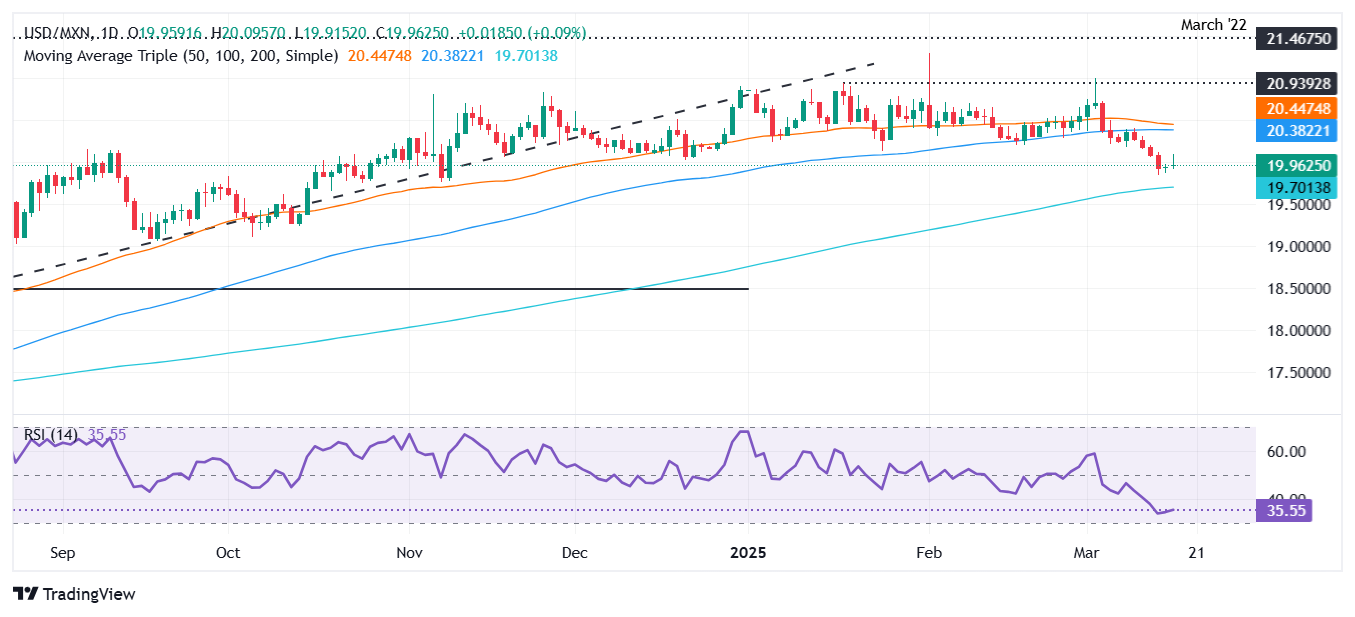- Mexican Peso weakened 0.14% as risk-off sentiment and profit-taking weigh ahead of the Fed’s policy decision.
- US data is mixed, with strong industrial production but weak housing figures, while Trump’s trade rhetoric overshadows economic releases.
- Mexico’s economic slowdown is in focus, with Aggregate Demand and Private Spending data due before Banxico’s March 27 meeting.
The Mexican Peso (MXN) lost some ground against the US Dollar (USD) on Tuesday as traders brace for the United States (US) Federal Reserve (Fed) monetary policy decision on Wednesday. Data from the US was mixed, though it was overshadowed by US President Donald Trump’s trade rhetoric. The USD/MXN is trading at 19,94, up by 0.14%.
The market mood turned pessimistic as investors seemed to book profits ahead of the Fed’s meeting. Participants expect the Fed to stay pat while eyeing whether it will adopt a dovish or hawkish tilt on its forecasts in the Summary of Economic Projections (SEP).
Earlier, data from the US revealed that Industrial Production improved, yet housing data was mixed. However, the main driver remains Trump’s policies and geopolitical developments.
In Mexico, the Instituto Nacional de Estadística Geografía e Informatica (INEGI) will feature the release of Aggregate Demand and Private Spending data, each on Wednesday and Thursday. This could show how deep the ongoing slowdown in Mexico’s economy is a week before the Banco de Mexico (Banxico) March 27 monetary policy meeting.
Daily digest market movers: Mexican Peso trims Monday’s gains ahead of Fed’s meeting
- The Organization for Economic Cooperation and Development (OECD) claimed that US President Donald Trump’s tariffs on Mexican products could spur a recession in Mexico.
- The OECD updated its forecasts, which include 25% tariffs applied on most goods from April. The OECD projects that Mexico’s economy will be severely impacted, contracting 1.3% in 2025 and 0.6% next year.
- Last Wednesday, Mexican Finance Minister Edgar Amador Zamora said the national economy is expanding but shows signs of slowing down linked to trade tensions with the US.
- US Industrial Production grew 0.7% MoM in February, surpassing expectations of 0.2% and accelerating from January’s 0.3% increase, driven by strength in motor vehicle production.
- Housing data presented a mixed picture. Building Permits declined 1.2%, falling from 1.473 million to 1.456 million. Housing Starts, however, surged 11.2%, rising from 1.35 million to 1.501 million, signaling stronger construction activity.
- Money market has priced in 61 basis points of easing by the Fed in 2025, which has sent US Treasury yields plunging alongside the American Currency.
USD/MXN technical outlook: Mexican Peso retreats as USD/MXN climbs above 19.90
USD/MXN registers anemical gains, yet the exotic pair remains below the 20.00 figure, suggesting that further downside is seen. Price action forms a ‘gravestone doji,’ implying that bears are in charge. The Relative Strength Index (RSI) is in bearish territory but hints buyers halted the downtrend near the 19.90 – 20.00 range.
A breach of 19.90 would exacerbate a drop to challenge the 200-day Simple Moving Average (SMA) at 19.65. Once hurdled, the next key support levels would be 19.50, 19.00, and the August 20, 2024 low at 18.64.
Conversely, if USD/MXN rallies past 20.00, this would clear the path to test the 100-day SMA at 20.35.

Banxico FAQs
The Bank of Mexico, also known as Banxico, is the country’s central bank. Its mission is to preserve the value of Mexico’s currency, the Mexican Peso (MXN), and to set the monetary policy. To this end, its main objective is to maintain low and stable inflation within target levels – at or close to its target of 3%, the midpoint in a tolerance band of between 2% and 4%.
The main tool of the Banxico to guide monetary policy is by setting interest rates. When inflation is above target, the bank will attempt to tame it by raising rates, making it more expensive for households and businesses to borrow money and thus cooling the economy. Higher interest rates are generally positive for the Mexican Peso (MXN) as they lead to higher yields, making the country a more attractive place for investors. On the contrary, lower interest rates tend to weaken MXN. The rate differential with the USD, or how the Banxico is expected to set interest rates compared with the US Federal Reserve (Fed), is a key factor.
Banxico meets eight times a year, and its monetary policy is greatly influenced by decisions of the US Federal Reserve (Fed). Therefore, the central bank’s decision-making committee usually gathers a week after the Fed. In doing so, Banxico reacts and sometimes anticipates monetary policy measures set by the Federal Reserve. For example, after the Covid-19 pandemic, before the Fed raised rates, Banxico did it first in an attempt to diminish the chances of a substantial depreciation of the Mexican Peso (MXN) and to prevent capital outflows that could destabilize the country.
Information on these pages contains forward-looking statements that involve risks and uncertainties. Markets and instruments profiled on this page are for informational purposes only and should not in any way come across as a recommendation to buy or sell in these assets. You should do your own thorough research before making any investment decisions. FXStreet does not in any way guarantee that this information is free from mistakes, errors, or material misstatements. It also does not guarantee that this information is of a timely nature. Investing in Open Markets involves a great deal of risk, including the loss of all or a portion of your investment, as well as emotional distress. All risks, losses and costs associated with investing, including total loss of principal, are your responsibility. The views and opinions expressed in this article are those of the authors and do not necessarily reflect the official policy or position of FXStreet nor its advertisers. The author will not be held responsible for information that is found at the end of links posted on this page.
If not otherwise explicitly mentioned in the body of the article, at the time of writing, the author has no position in any stock mentioned in this article and no business relationship with any company mentioned. The author has not received compensation for writing this article, other than from FXStreet.
FXStreet and the author do not provide personalized recommendations. The author makes no representations as to the accuracy, completeness, or suitability of this information. FXStreet and the author will not be liable for any errors, omissions or any losses, injuries or damages arising from this information and its display or use. Errors and omissions excepted.
The author and FXStreet are not registered investment advisors and nothing in this article is intended to be investment advice.



